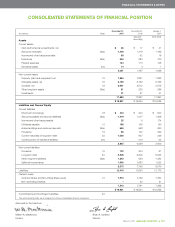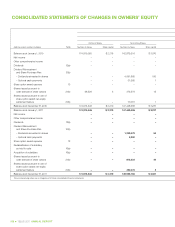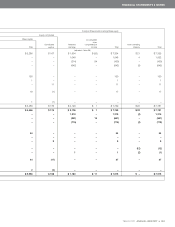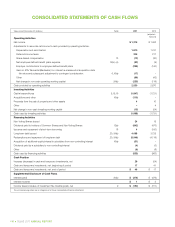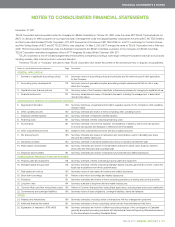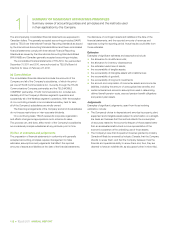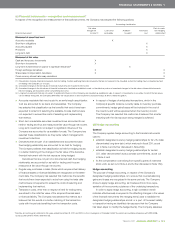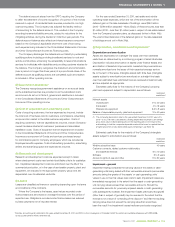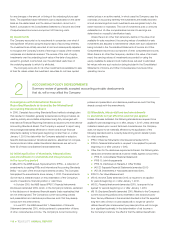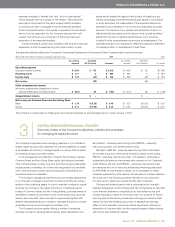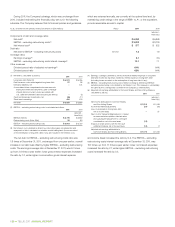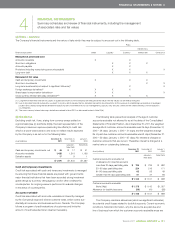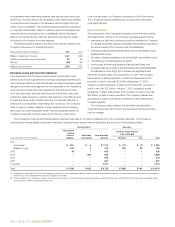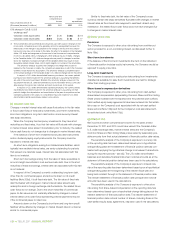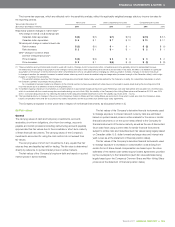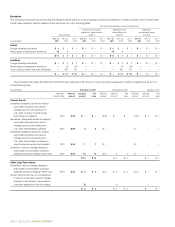Telus 2011 Annual Report Download - page 121
Download and view the complete annual report
Please find page 121 of the 2011 Telus annual report below. You can navigate through the pages in the report by either clicking on the pages listed below, or by using the keyword search tool below to find specific information within the annual report.
TELUS 2011 ANNUAL REPORT . 117
FINANCIAL STATEMENTS & NOTES: 1
Share option awards which have a net-cash settlement feature, as
set out in Note 13(b), are accounted for as liability instruments. If share
option awards which have the net-cash settlement feature and which
were granted subsequent to 2001 were to be settled using other than
the net-cash settlement feature, they would be accounted for as equity
instruments.
In respect of restricted stock units, as set out in Note 13(c), the
Company accrues a liability equal to the product of the vesting restricted
stock units multiplied by the fair market value of the corresponding
shares at the end of the reporting period (unless hedge accounting is
applied, as set out in Note 1(d)). The expense for restricted stock units
that do not ultimately vest is reversed against the expense that had
been previously recorded in their respect.
When share-based compensation vests in its entirety at one future
point in time (cliff vesting), the expense is recognized by the Company
on a straight-line basis over the vesting period. When share-based com-
pensation vests in tranches (graded vesting), the expense is recognized
by the Company using the accelerated expense attribution method.
An estimate of forfeitures during the vesting period is made at the date
of grant; such estimate is adjusted for actual experience.
(n) Employee future benefit plans*
Defined benefit plans
The Company accrues for its obligations under employee defined
benefit plans, and the related costs, net of plan assets. The cost of pen-
sions and other retirement benefits earned by employees is actuarially
determined using the projected benefit method pro-rated on service
and management’s best estimate of expected plan investment perfor-
mance, salary escalation and retirement ages of employees. For the
purpose of calculating the expected return on plan assets, those assets
are valued at fair value. Actuarial gains (losses) arising subsequent to,
or on, January 1, 2010, the date of the Company’s transition to IFRS-IASB,
are recognized in other comprehensive income in the period in which
they arise as the Company believes that this better reflects the long-term
nature of employee future benefits. See Note 2(b) for significant
amendments to the employee benefits accounting standard which
are not yet effective and have not yet been applied.
As discussed further in Note 25, unamortized actuarial gains (losses),
past service costs and transitional assets (obligations) at January 1, 2010,
were recognized directly in retained earnings at the transition date to,
and as permitted by, IFRS-IASB.
On an annual basis, at a minimum, the defined benefit plan key
assumptions are assessed and revised as appropriate. When the defined
benefit plan key assumptions fluctuate significantly relative to their
immediately preceding year-end values, actuarial gains (losses) arising
from such significant fluctuations are recognized on an interim basis.
Defined contribution plans
The Company uses defined contribution accounting for the Telecommu-
nication Workers Pension Plan and the British Columbia Public Service
Pension Plan that cover certain of the Company’s employees, both of
which provide defined benefits to their members. In the absence of any
regulations governing the calculation of the share of the underlying
financial position and plan performance attributable to each employer-
participant, and in the absence of contractual agreements between
the plans and the employer-participants related to the financing of any
shortfall (or distribution of any surplus), these plans are treated by the
Company as defined contribution plans in accordance with International
Accounting Standard 19, Employee Benefits.
(o) Cash and temporary investments, net
Cash and temporary investments, which may include investments in
money market instruments that are purchased three months or less
from maturity, are presented net of outstanding items including cheques
written but not cleared by the bank as at the statement of financial
position date. Cash and temporary investments, net, are classified as a
liability on the statement of financial position when the amount of the
cheques written but not cleared by the bank exceeds the amount of cash
and temporary investments. When cash and temporary investments,
net, are classified as a liability, they may also include overdraft amounts
drawn on the Company’s bilateral bank facilities, which revolve daily
and are discussed further in Note 17.
(p) Sales of trade receivables*
Sales of trade receivables in securitization transactions are recognized
as collateralized short-term borrowings and thus do not result in the
Company’s derecognition of the trade receivables sold.
(q) Inventories
The Company’s inventory consists primarily of wireless handsets, parts
and accessories and telecommunications equipment held for resale.
Inventories are valued at the lower of cost and net realizable value,
with cost being determined on an average cost basis. Previous write-
downs to net realizable value are reversed if there is a subsequent
increase in the value of the related inventories.
(r) Property, plant and equipment; intangible assets*
General
Property, plant and equipment and intangible assets are recorded at
historical cost and, with respect to self-constructed property, plant and
equipment, include materials, direct labour and applicable overhead costs.
With respect to internally developed, internal-use software, recorded
historical costs include materials, direct labour and direct labour-related
costs. Where property, plant and equipment construction projects are
of a sufficient size and duration, an amount is capitalized for the cost of
funds used to finance construction. The rate for calculating the capitalized
financing costs is based on the Company’s weighted-average cost of
borrowing experienced during the reporting period.
When property, plant and/or equipment are sold by the Company,
the net book value is netted against the sale proceeds and the difference,
as set out in Note 6, is included in the Consolidated Statements of
Income and Other Comprehensive Income as Other operating income.
Asset retirement obligations
Provisions for liabilities, as set out in Note 19, are recognized for statutory,
contractual or legal obligations, normally when incurred, associated
with the retirement of property, plant and equipment (primarily certain
items of outside plant and wireless site equipment) when those obliga-
tions result from the acquisition, construction, development and/or
normal operation of the assets. The obligations are measured initially
at fair value, determined using present value methodology, and the
resulting costs are capitalized into the carrying amount of the related
asset. In subsequent periods, the liability is adjusted for the accretion
of discount, for any changes in the market-based discount rate and
*Denotes accounting policy affected in the years ended December 31, 2011 and 2010, by the convergence of Canadian GAAP for publicly accountable enterprises with IFRS-IASB,
as discussed further in Note 2 and Note 25.


